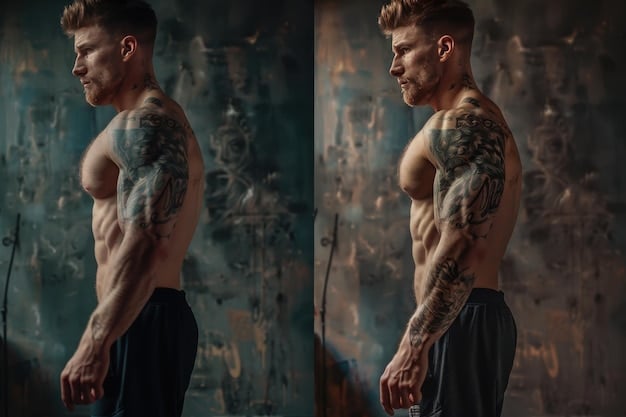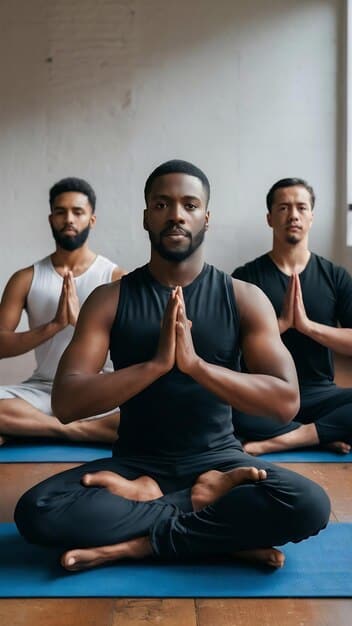Recognizing and Addressing Male Body Image Issues: A Comprehensive Guide

Recognizing and Addressing Male Body Image Issues: A Guide to Building Self-Esteem and Confidence involves understanding societal pressures, challenging unrealistic beauty standards, and developing strategies for self-acceptance. This guide provides practical steps for men to improve their mental well-being and body satisfaction.
Body image issues are often seen as a female problem, but men struggle with them too. The pressure to attain a perfect physique, fueled by media and societal expectations, can significantly impact mental health. Recognizing and Addressing Male Body Image Issues: A Guide to Building Self-Esteem and Confidence is the first step toward positive change.
This guide aims to shed light on the challenges men face, offering practical strategies to build self-esteem and foster a healthier relationship with their bodies. Through increased awareness and actionable steps, men can navigate these pressures, promoting better mental and physical wellbeing.
Understanding Male Body Image Issues
Male body image issues are complex and often overlooked. Unlike women, whose struggles are more openly discussed, men frequently face pressure to conform to ideals of muscularity and leanness in silence. Recognizing these pressures is the first step in recognizing and addressing male body image issues: A guide to building self-esteem and confidence.
What are the Key Pressures Men Face?
Societal expectations often portray men as strong, muscular, and physically fit. This can lead to dissatisfaction and negative self-perception when reality doesn’t align with these unrealistic standards. The media further reinforces these ideals, showcasing sculpted physiques and promoting extreme workout routines and diets.
How Does Social Media Contribute to the Problem?
Social media platforms are major drivers of body image concerns. The constant exposure to carefully curated and often unrealistic images of male bodies can create a sense of inadequacy. This phenomenon, known as social comparison, often results in lower self-esteem and a distorted perception of oneself.
- Unrealistic expectations set by influencers
- Constant comparison with “perfect” bodies
- Promotion of unhealthy diets and workout routines
- Cyberbullying related to physical appearance

Understanding the sources of these pressures is crucial for recognizing and addressing male body image issues: A guide to building self-esteem and confidence. By acknowledging the role of societal expectations and social media, men can begin to critically evaluate and challenge the narratives that contribute to their body image concerns.
The Mental Health Impact of Body Image Concerns
Body image concerns are not merely cosmetic issues; they have a profound impact on men’s mental health. The constant pressure to achieve an unattainable ideal can lead to a host of psychological problems. Understanding this impact is critical for recognizing and addressing male body image issues: A guide to building self-esteem and confidence.
What are the Common Mental Health Issues?
Men experiencing body image dissatisfaction are more susceptible to anxiety, depression, and low self-esteem. The relentless pursuit of a perfect body can lead to obsessive thoughts and behaviors, further exacerbating these conditions. Eating disorders, such as anorexia and bulimia, which are often overlooked in men, can also develop.
How Does Body Dysmorphic Disorder Relate?
Body dysmorphic disorder (BDD) is a severe mental health condition characterized by obsessive preoccupation with perceived flaws in one’s appearance. Men with BDD may spend hours scrutinizing their bodies, seeking reassurance, or undergoing unnecessary cosmetic procedures.
The mental health impacts of recognizing and addressing male body image issues: A guide to building self-esteem and confidence are significant, highlighting the need for interventions and support. Addressing these mental health issues is crucial when attempting to improve one’s body satisfaction.
Strategies for Building Self-Esteem
Building self-esteem is a cornerstone of recognizing and addressing male body image issues: A guide to building self-esteem and confidence. It involves reframing negative self-perceptions and fostering a more positive and accepting attitude toward one’s body. Practical strategies can empower men to cultivate self-worth and confidence.
How Can Cognitive Restructuring Help?
Cognitive restructuring involves identifying and challenging negative thoughts and beliefs about one’s body. By replacing these with more realistic and positive thoughts, men can gradually shift their perception and improve their self-esteem. This therapeutic approach helps to break the cycle of negative self-talk.
What Role Does Mindfulness Play?
Mindfulness practices, such as meditation and deep breathing exercises, can help men become more aware of their thoughts and feelings without judgment. By focusing on the present moment, they can reduce anxiety and develop a greater sense of self-acceptance, which contributes immensely to recognizing and addressing male body image issues: A guide to building self-esteem and confidence.
- Practice gratitude: Focus on positive aspects of your body and life.
- Challenge negative thoughts: Replace them with realistic affirmations.
- Set realistic goals: Focus on health and well-being, not perfection.
By integrating these strategies into daily life, men can begin to cultivate a stronger sense of self-worth and resilience, directly aiding in recognizing and addressing male body image issues: A guide to building self-esteem and confidence.

Promoting a Healthy Relationship with Your Body
Fostering a healthy relationship with your body involves embracing self-acceptance, practicing self-care, and focusing on overall well-being rather than just physical appearance. Making active decisions to improve your body relationship can be a major part of recognizing and addressing male body image issues: A guide to building self-esteem and confidence.
Why Is Self-Acceptance Important?
Self-acceptance is about embracing your body as it is, with all its imperfections. It means recognizing that your worth is not tied to your physical appearance. Cultivating self-acceptance can significantly reduce body image anxiety and promote overall well-being.
How Can Physical Activity Help?
Engaging in regular physical activity, not for achieving a specific physique, but for improving overall health and well-being, can be transformative. Choose activities you enjoy, focusing on how they make you feel rather than how they make you look. Enjoyment contributes greatly in recognizing and addressing male body image issues: A guide to building self-esteem and confidence.
By prioritizing self-care and engaging in positive, health-focused activities, men can develop a more compassionate and accepting relationship with their bodies. Using exercise and diet for mental and physical well being, rather than to achieve a certain standard, aids greatly in recognizing and addressing male body image issues: A guide to building self-esteem and confidence.
Seeking Professional Support
Sometimes, body image issues can be deeply ingrained and require professional intervention. Seeking help from therapists, counselors, or support groups can provide men with the guidance and tools they need to overcome their challenges. Counseling can provide great aid in recognizing and addressing male body image issues: A guide to building self-esteem and confidence.
When Should You Seek Professional Help?
If body image concerns are significantly impacting your daily life, relationships, or mental health, it’s time to seek professional support. Symptoms like obsessive thoughts, compulsive behaviors, or feelings of hopelessness warrant immediate attention.
What Types of Therapy are Effective?
Cognitive-behavioral therapy (CBT) and body image therapy are effective treatments for body image issues. CBT helps individuals identify and change negative thought patterns, while body image therapy focuses specifically on improving body perception and acceptance. Support groups also provide a safe and supportive environment for sharing experiences and coping strategies.
| Key Point | Brief Description |
|---|---|
| 💪 Societal Pressure | Unrealistic expectations of muscularity and fitness. |
| 🧠 Mental Health | Body image issues can lead to depression and anxiety. |
| ❤️ Self-Esteem | Building self-esteem involves reframing negative thoughts. |
| 🫂 Professional Support | Therapy can provide guidance and tools for recovery. |
Frequently Asked Questions
Common signs include excessive concern with muscle mass, constant mirror checking, compulsive exercise, and social withdrawal due to appearance anxieties. These can significantly impact daily life.
Social media often presents unrealistic ideals, leading to social comparison and feelings of inadequacy. Curated images can skew perceptions of what is achievable or normal, impacting self-esteem.
Yes, addressing body image concerns can improve mental health by reducing anxiety, depression, and self-esteem issues. Improved self-perception and more positive body image often relieve inner stress.
Practical tips include practicing gratitude, setting realistic goals, engaging in physical activity for enjoyment (not just appearance), and challenging negative thoughts with positive affirmations for boosted self-esteem.
Therapy, such as CBT, can help identify and change negative thought patterns related to body image. It provides tools to develop healthier perceptions and cope with societal pressures effectively.
Conclusion
Recognizing and Addressing Male Body Image Issues: A Guide to Building Self-Esteem and Confidence is crucial for improving men’s mental and physical well-being. By understanding the pressures, implementing coping strategies, and seeking support when needed, men can foster a healthier relationship with their bodies.
Adopting these practices can empower men to challenge unrealistic ideals, build self-esteem, and live more fulfilling lives, free from the constraints of body image concerns. Prioritizing mental health and body acceptance are key for achieving a more balanced and positive self-image.





